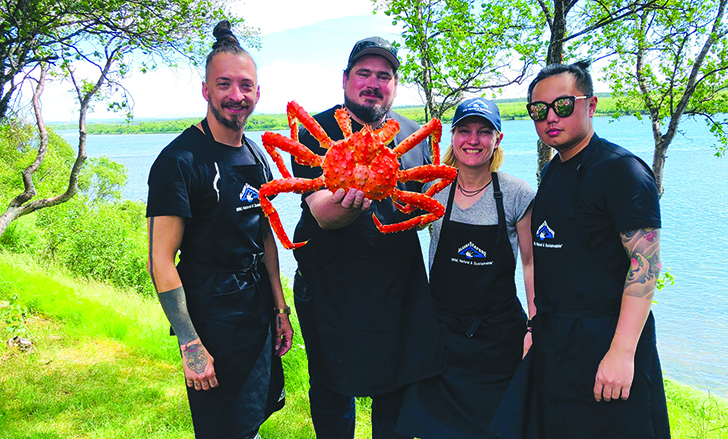The Alaska Seafood Marketing Institute hosts an annual culinary retreat to showcase sustainable seafood. Here are highlights from this year.
Nothing can prepare you for the sheer beauty of Alaska until you witness for yourself the soaring snow-capped mountains, expansive countryside and crystal-clear waters.
I was lucky enough to fly over from the UK in June to participate in a culinary retreat hosted by Alaska Seafood, to showcase the sustainable fishing that supports 7,000 fishermen in Bristol Bay.
As the plane landed in King Salmon, we caught our first glimpse of azure blue rivers and lakes and vast areas of grassland. One-third of the world’s sockeye salmon comes from Alaska’s Bristol Bay, and we were eager to find out more about sustainable fishing nearby.
We set off for a riverboat tour to learn more about the varieties of salmon in the area and how they are counted. The Alaska Department of Fish and Game was on hand to tell us about the way salmon fishing is strictly regulated. In recent years, Bristol Bay has seen some of the largest recorded runs of wild salmon. Careful management of the numbers ensures that wild salmon remain sustainable and abundant in these waters. That evening, several chefs in our group prepared a feast featuring all five Alaska salmon species.
The next day we headed off for a setnet site visit, where we were treated to a display showing how Bristol Bay salmon are harvested, by fisherman Melanie Brown, who demonstrated the way each salmon is hand-picked from the net before being chilled to preserve its freshness. Melanie and her family have been fishing in Bristol Bay for three generations, and her mother also continues to fish there, too. A pod of Beluga whales popped up to say hello — apparently quite a rare sighting even for the veteran fishermen of the area!
Back on dry land we met another local fisherman who showed us his traditional smokehouse, where he expertly smokes rows of salmon until they reach the perfect flavor. Later we toured a processing plant where we learned in detail how salmon are processed for sale, from the moment they are delivered to the dock. A huge team of workers was involved, busily ensuring that each salmon is checked for quality before being prepared for shipment, and the whole plant was a bustling hive of activity.
That night the chefs prepared a stunning array of Alaska king and snow crab, halibut, sablefish, pollock, cod, scallops and oysters.
The next day, we set off on float planes for Katmai National Park and Preserve. The rivers that wind through Katmai National Park are full of salmon as they make their all-important jump to try to get upstream. These salmon provide the ideal feeding ground for the world-famous bears who have worked up an appetite over the winter. It was an incredible trip hosted by Alaska Seafood, and we learned so much about the importance of sustainable fishing to local livelihoods. — Camille Allcroft
I was extremely thankful for the opportunity to visit Alaska and get first-hand impressions onsite. Visiting Naknek was an especially great experience because we got to ride along on a fishing vessel and meet a small salmon smoker. It was highly interesting to learn how the fish is handled and prepared in such an old-school, artisan type of operation.
The culinary retreat was a once in a lifetime opportunity to gain knowledge and improve my own expertise while being able to discuss and exchange ideas and impressions with other international visitors. It was the ideal way to widen my culinary horizon because I not only gained knowledge about the origin of Alaska seafood, but also connected with chefs and professionals with different backgrounds bringing new opinions and concepts to the table.
Even before coming to Alaska, I was working with wild salmon and salmon roe, but having the fresh product at hand for cooking even increased my interest in and appreciation of the product. When cooking with fresh wild Alaska salmon, the quality and pure taste was unique and simply a joy for every chef to work with.
Most impressive for me, aside from the actual seafood, was how Alaskans and the industry deal with the subject of sustainable management of the natural resources. I did not know that the principles of sustainable management are written into the state’s constitution. Seeing the nature and wilderness of Alaska and how people live and work in this remote place dedicating their life to preserving it for the future influenced my view on Alaska seafood. From a business perspective it helped me understand why it is worth investing more for wild, sustainably caught Alaska seafood.
Since coming back from Alaska, I look forward to ordering different Alaska products available in Germany — such as sockeye, blackcod or cod — and developing new dishes. I also want to continue working with ASMI, collaborating with chefs and colleagues, sharing the experience and knowledge gained during the culinary retreat to highlight Alaska seafood at future events. — Volker Beuchert







